When Facebook was first launched, it was just for friends who want to connect & share updates. Similarly, Twitter was also meant to be a miniature version of a personal blog. Fast forward to this day, and all these social media platforms have evolved into very popular marketing channels.
Social media marketing is now more than a buzzword. It is a proven channel that is used by businesses of all sizes with great success. In fact, you must have heard one or more stories of how a small brand turned the tables on the competition by executing a brilliant social media campaign that went viral and brought the brand into the limelight.
Let’s dive into the world of social media marketing & see how you can master the art of running social media campaigns.
What is Social Media Marketing?
Social media marketing uses social media platforms (like Facebook, Twitter, LinkedIn, Pinterest, etc.) to connect your brand with your audience. You carry out social media campaigns to build your brand, increase brand awareness, generate more sales & drive traffic to your website. Social media provides excellent opportunities for reaching your target audience and customers.
When planning and executing campaigns, social media management tools can help you make the most of social media platforms. For example, Social Champ is a social media tool that can help you achieve your social media marketing goals.
Before we dig deep into social media marketing strategy & plan, let’s check out some basic terms & definitions first.
Social Media Marketing Guide: Terms & Definitions
To develop a winning social media marketing strategy, you need to know some standard terms.
- Social Media: An online platform that facilitates the sharing of ideas and information by building virtual communities & networks.
- Content: Whatever you create and post on social media is social media content. It can be text, visuals, videos, or a combination of these three. Content is the most crucial element of social media marketing. In fact, the only two things that matter the most are the content you post on the platforms & how the audience interacts with it.Let’s go into the specifics of these content formats to understand how these formats add value to your social media marketing campaigns.
- Text
The text has been the mainstay of social media. In the early days of social media, text was prevalent in the form of status updates on Facebook or tweets on Twitter. But now, all the text-heavy channels are rapidly shifting towards visuals.
- Visual Images
This includes photos, illustrations, infographics, & animated GIFS. You can easily imagine the possibilities of these formats. With the help of the images, you can demonstrate complex concepts easily & quickly.
- Videos
Videos can be used on all social media platforms and have become the most consumed type of content these days. Cisco reported that online videos would make more than 82% of all global consumer traffic in 2022. Live videos are also becoming very popular these days on many social platforms. Short videos of 10-30 seconds are also very popular on platforms such as TikTok.
- Stories (and similar short animated updates)
Another content format that has rapidly become popular on almost all major platforms. The trend started at Snapchat and has now spread to all platforms. These are usually short-lived (usually 24 hours) bits of content with both video & photos, fun filters, and stickers.
Other types of content like polls, surveys, & quizzes can help you grow your business and engage with your audience.
- Engagement: This term refers to how people interact with your social media content. For example, you posted a photo on your Facebook page, and people reacted, commented, or shared it. That’s the engagement on the post.
- Reach: This term defines the total number of users who have come across your social media content. Reach can be of two types.
- Organic Reach: The one that doesn’t involve any paid activity.
- Paid Reach: When you put in some money to reach more audience.
- Impressions: This is the number of times your content is displayed. It doesn’t matter if people click the post or view it.

- Hashtags: Hashtags are phrases used to classify content on social media platforms. It’s a metadata tag that starts with a hash symbol. These are used to enable cross-referencing for content sharing. Hashtags make content easy to discover and share with interested users.
- Shares: The number of shares is perhaps the most-valued social media metric. A share is counted when your content is shared by others.
- Viral Marketing: This is perhaps the most-used term in the social media world. The process of going viral involves sharing a content piece at an ever-increasing rate. The rate of “virality” depends upon several factors, including the social media channel, the intended audience, and the creativity of the content.
- Social Media Management: This is the process of managing the online presence of a brand on social media platforms. The process involves creating, publishing content on different social media platforms, and then analyzing the performance of the content. It also includes engaging with users, interacting & building online communities that bring together interested users and try to convert them into sales leads.
- Social Media Management Tools: These tools are indispensable in managing social media-related processes, including managing social media accounts. They can help you in scheduling content, publishing, monitoring, engaging & analyzing the metrics.
- Social Media Metrics: Marketers use these parameters to measure the performance of social media campaigns. Standard metrics include shares, likes, comments, CTA clicks, traffic, etc.
- Conversion Rate: It’s the ratio of the number of visitors on your post who took any action to the total visitors.
- Click-Through Rate: CTR is how often users click on the call-to-action link in your post. It should not be confused with other engagement actions like comments or shares. CTR is measured for the link that brings your audience to the additional content or a web page.
- User-Generated Content (UGC): UGC can be any form of content (text, images, GIFs, or videos) that is produced & shared online by users or consumers. Any brand can share UGC (after proper permission) on their social accounts. For instance, you own a coffee shop, & one of your customers uploaded a picture of your latte & tagged you on their Instagram handle. You can repost their post on your account.
- Social Media Campaigns: This refers to a series of coordinated activities executed across a single or multiple social media platforms with a specific goal over a set period. The results of these activities can be tracked & evaluated to discover the shortcomings. A lot of effort goes into the planning and execution of a successful social media campaign.
- Content Strategy: A content strategy is an approach for creating content that drives critical business objectives. It’s a higher-level planning process that involves thinking, writing, designing, & distributing content that satisfies business needs.
- Social Media Marketing Strategy: Social media marketing strategy summarizes everything you do or plan to do to achieve your social media goals.

Social Media Quotes Guide
Subscribe and gain instant access to fun-packed yet informative social media quotes. Enjoy!
An Overview of Popular Social Media Platforms
Now that you know the basic terms & definitions of social media marketing let’s move on to an overview of some of the leading social media platforms so that you can decide which one is the best for you.
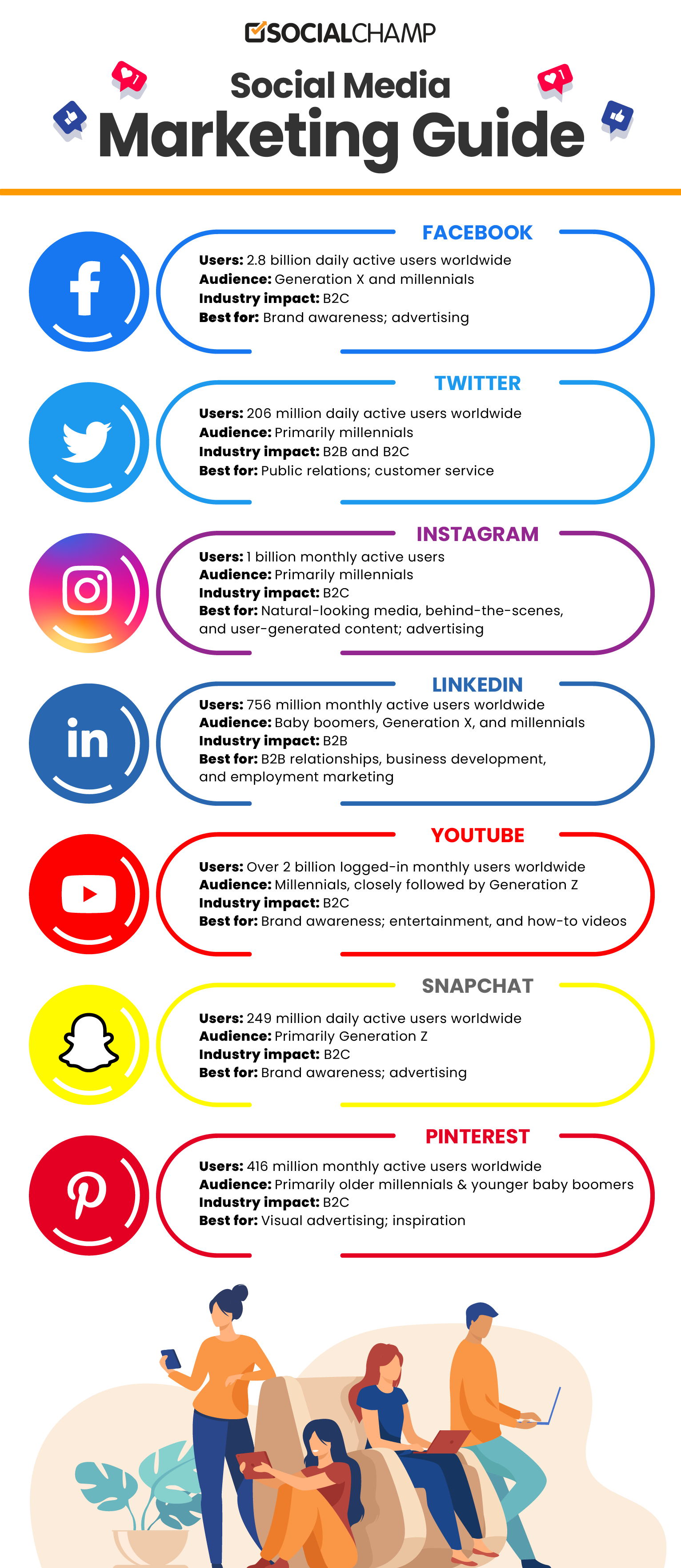
Facebook
Facebook is perhaps the largest social media network out there. For businesses, the free Facebook Business Suite tool provides many options for promoting the services and offers. The suite offers a single place to manage your marketing performance. You can select a goal (for example, driving traffic to your website or getting more conversions), and Facebook gives you sea lot of options for creating the targeted audience. Here are a few ways you can use Facebook to advertise your product:
- Facebook Business Page
- Facebook Groups
- Live Stream
- Facebook Stories
- Paid Campaigns
Instagram
Instagram is mostly about pictures & videos and has a very high engagement rate. You can post short videos & photos on Instagram. With IGTV, you can create long-form videos. Instagram also offers ‘Reel,’ an exciting feature you can use to increase engagement & reach more audiences. You can also use Instagram stories with GIFs & filters to keep your audience interested. If you are just starting out on Instagram, you need to understand the use of images with proper hashtags in order to start building an audience. You can also branch out into images and videos about your products and services.
Once you think the audience has been built, you can explore Instagram influencer marketing.
LinkedIn
LinkedIn is all about being professional. The casual writing style of telling people what you’re having in lunch doesn’t work on LinkedIn. People are there for business reasons and to learn what’s new in their industries.
Creating content that helps people handle their work efficiently and grow their business gives you better traction on the platform. You can use LinkedIn groups & paid advertising to promote your business.
Pinterest
Pinterest is the platform people go to when they’re looking for an image. It’s like a digital scrapbook because of its unique way of displaying images in a continuous vertical display. So when posting to Pinterest.
Growing your audience on Pinterest might take a lot of time, and brands often turn to influencer marketing to promote their products. Alternatively, the brands can invest in paid advertising on Pinterest.
YouTube
This is the social platform that has changed the way people consume videos. It’s super-fast, free & has everything you can ask from a social media platform. Many individuals kick-started their careers with YouTube.
It’s a great way to share long-form video content. DIY, Behind-the-scene, recipes, podcasts are among the most-watched video types on YouTube. The best part is that you don’t need fancy editing tools, high-quality recording equipment, or a studio to get started.
YouTube recently launched the Stories feature that works similar to other platforms. You can also use YouTube ads for advertising your product or service.
Benefits of Social Media Marketing
Whether you’re a small business, ecommerce brand, or restaurant, you can get a lot of leads and customers from whatever social media platforms you include in your marketing mix.
Just look at the number:
Globally, over 3.6 billion people use social media. This number is projected to increase to 4.41 billion by 2025.
That’s a massive reach potential in your hands. But that is not everything.
Many businesses still consider social media as a way to reach the end-user. As such, they see little potential in reaching out to other vendors and companies. This is a severe issue for businesses in B2B industries that depend upon a chain of vendors for sales.
How Social Media Marketing Benefits B2B Businesses?
Social media marketing is incredibly beneficial for B2B businesses as almost every business out there is looking for customers. To get new customers, you need to build a positive perception of your brand. For this, you need to share valuable tips that entrepreneurs can use, and they will be more than willing to come to you for help.
Canva does this really well. Canva is an online graphic design platform built for individuals and businesses. They have a fabulous social media presence where they share content focusing on online business and entrepreneurship. Their strategy is based on delivering so much value that they become the leading choice for companies looking for a graphic design platform.
If you are going to do this as well, you will be able to get a lot of new leads and, in the end, customers in the B2B market.
Social media is an excellent opportunity for building credibility for B2B companies. Suppose you are a valuable source for your audience. In that case, you will establish your brand as an authority and a reputable resource in your industry.
Social media advertising is another great benefit and probably the most crucial reason why a B2B brand opts for social media marketing in the first place.
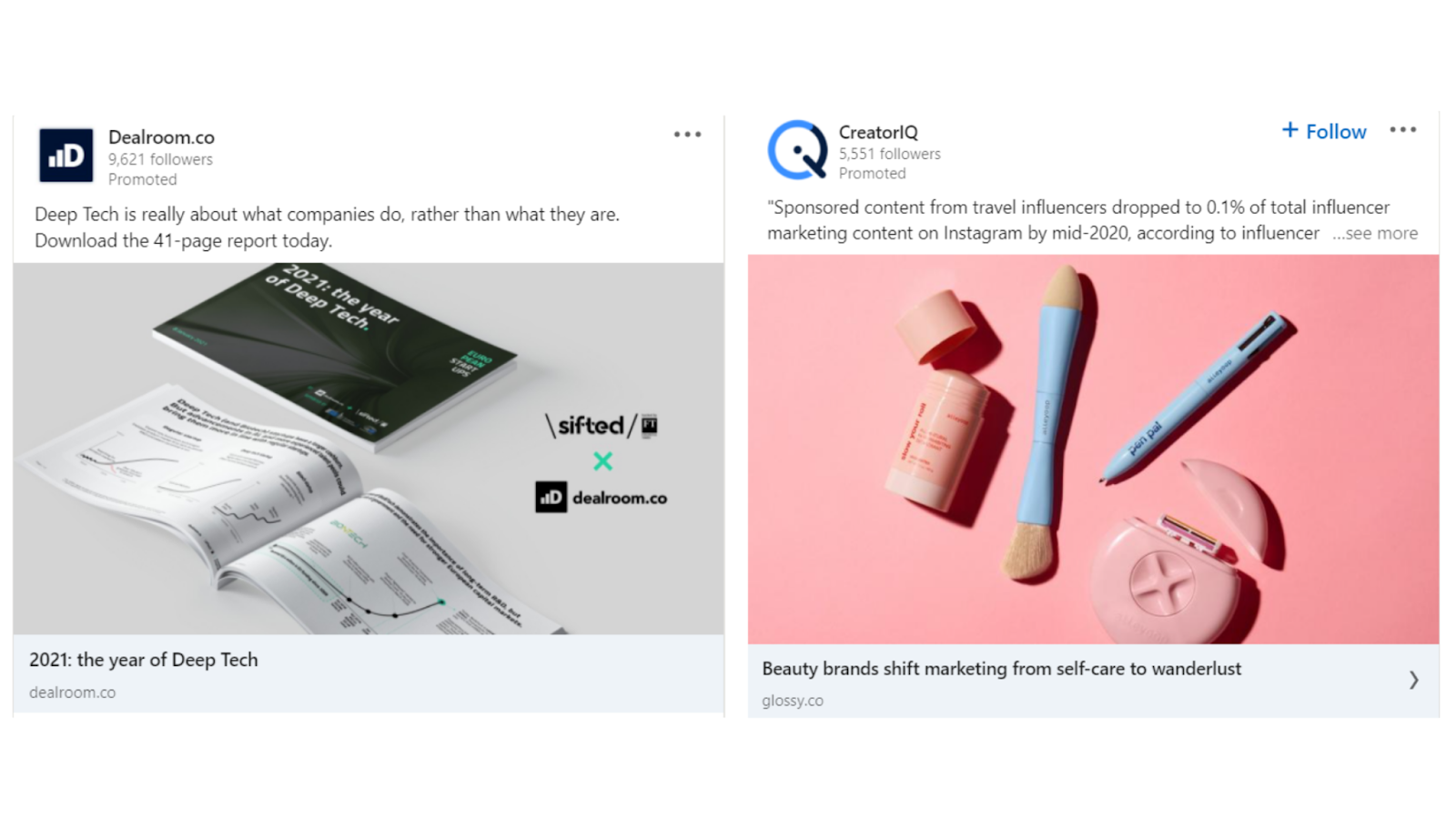 Ads on social media are heavily underpriced, and that’s why you can use them to drive a ton of new leads and customers to your business at a relatively low cost. That is huge! For example, advertising on Facebook and Instagram is heavily underpriced, and you can be massively successful with it.
Ads on social media are heavily underpriced, and that’s why you can use them to drive a ton of new leads and customers to your business at a relatively low cost. That is huge! For example, advertising on Facebook and Instagram is heavily underpriced, and you can be massively successful with it.
Platforms like LinkedIn sell more expensive ads, but for B2B companies, they can bring in more high-quality leads than Facebook or Instagram, so it is definitely worth the price.
How Social Media Marketing Benefit Small Businesses & Startups?
The benefits for small businesses and startups are oriented mainly around organic social media growth.
What is Organic Growth?
Organic growth means growing on social media without using any paid methods. For example, you add the right hashtags to your post, and 50 people who see it on the hashtag page follow you – that’s organic growth.
You didn’t use any ads, paid for shoutouts, nothing.
Great job!
But did you noticed that instead of investing money, you invested a lot of your time?
Since small businesses are often short on funds, this could be a good starting strategy for small businesses or startups that want to crack the social media challenge. They can attract tens of thousands of new followers and drive more traffic to the website. However, the trick is to stay consistent and create valuable content over a long time.
Social Media Powered Shopfronts
Almost every social media platform supports storefronts and online shops that allow businesses to sell directly to social media audiences. This opens up a great channel for companies that deal in products and already have an online presence. Social media shops feature greatly helps small businesses get new customers due to social media marketing campaigns.
Instagram Shopping is a fantastic example.
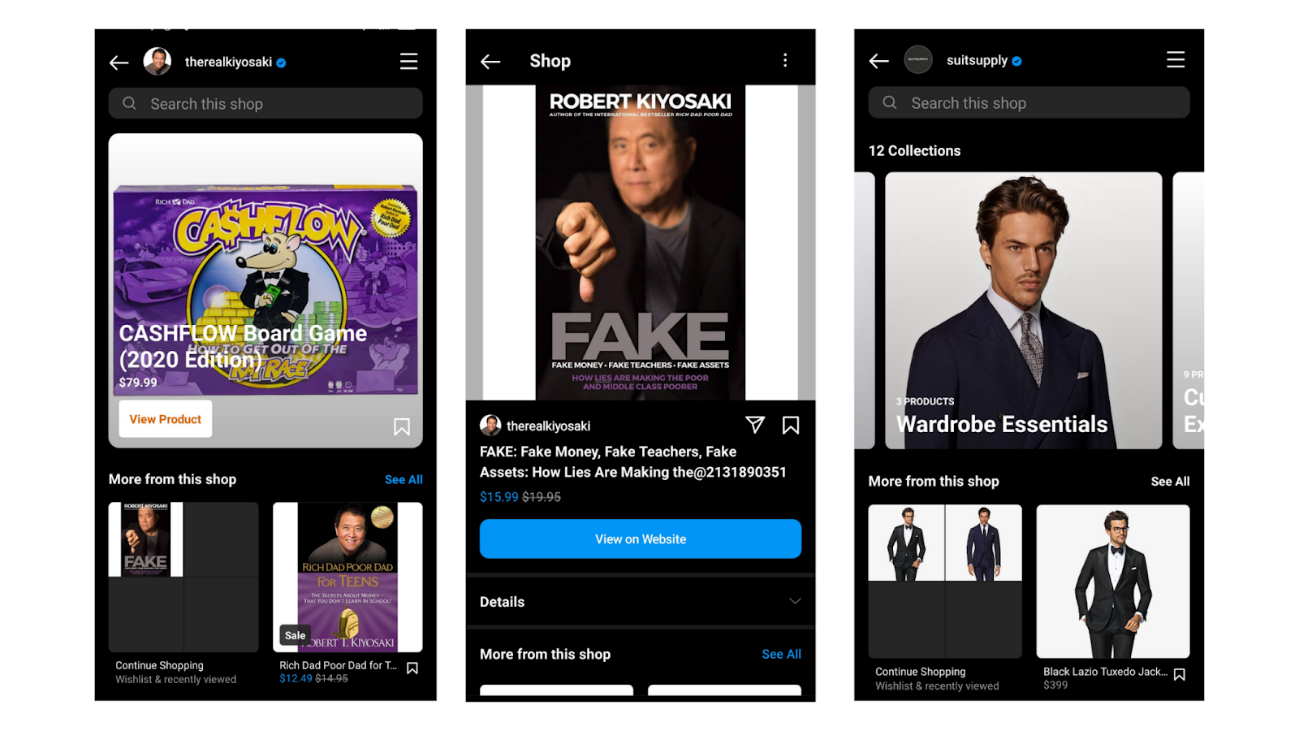
Instagram has recently started to seriously promote its Shopping feature, to help small businesses acquire thousands of new customers. It is a free way to promote your products and services, and because it works like a search engine, you really do not have to invest anything extra into using this feature.
Benefits of Social Media Marketing for Ecommerce Brands
Ecommerce brands can benefit from social media marketing in several ways.
First of all, they can advertise their products at very competitive rates. That can mean a ton of sales and new leads coming to your business every day. They can also acquire more email subscribers if they ask visitors to sign up for the newsletter. That way, they can follow up and promote every single day.
Every E-commerce brand should use social media marketing. The truth is that the paid growth is going to be of way higher importance than organic growth. But it is going to be worth it.
The Tool That Fits Your Budget
Get Social Media Calendar, Auto-RSS, Bulk Upload, Hashtag management, and support for all popular social networks without breaking the bank.
How To Start Social Media Marketing
If you want to start with social media marketing, you need to do three things:
- Determine which platform you are going to use.
- Create a content strategy.
- Decide whether you will prioritize organic or paid growth.
Since these steps are crucial for success, let’s dive a little bit deeper into how each factor works.
Determine Which Platform Are You Going To Use
This is perhaps the most difficult decision to make because of so many great choices. Popular choices include Instagram, Twitter, Facebook, LinkedIn, TikTok, Snapchat, Clubhouse, and YouTube.
Each platform focuses on a unique way of delivering content and caters to a specific slice of the audience. The choice comes down to the content formats and the audience you wish to reach.
First, the content type has to align with your brand. If your content is highly video-oriented, definitely opt for YouTube, Instagram, or TikTok. On the other hand, if you are more text or photo-oriented, choose LinkedIn, Instagram, or marketing on Twitter.
Second, you have to determine if your ideal customers are on that platform.
For example, for a B2B company, LinkedIn appears to be a good fit as it is 100% focused on a B2B audience with many opportunities for reaching the business-centric audience.
Create a Content Strategy
The right content strategy is essential for growth on social media.
Your content has to do three things:
- Nurture your audience
- Attract new followers
- Promote your products or services
If your content doesn’t do these three things, you need to reconsider your content creation and promotion approach. Each content piece should have a goal. This is particularly true for content created for social media because you need to come up with content that accomplishes the targets of the campaigns.
Decide Whether You Will Prioritize Organic or Paid Growth
As I already mentioned before, there are two ways to grow on social media – the paid way and the organic way.
The organic way is best for small businesses and startups short on funds or who want to invest their resources in other areas. The paid way is excellent for ecommerce brands and big companies that can spend more money on building their social media presence.
You have to decide which one you are going to use as your social media marketing strategy.
Creating a Successful Social Media Marketing Strategy
There are five basic steps of creating a winning social media marketing strategy to grow your business online.
- Research
- Decide
- Create
- Organize
- Analyze
Let’s cover them in detail.
Research
The first step is to research your buyer persona and audience.
The idea is to find out all about your audience. What are their needs & interests?
For example, if you’ve got a toy shop for kids under the age of 5, your consumers are children, but your target audience will be new parents or couples with young children. Or someone whose friend’s or close relatives kid’s birthday is around the corner.
Once you have clearly identified your target audience, you’ll research what type of content they consume.
The second thing you need to find out is what are your competitors in the industry doing.
The outcome of these research projects will help you create engaging content that your audience can relate to and consume regularly.
Decide
But, before creating content, you need to decide on your social media platforms. As I’ve discussed before, every platform emphasizes a unique way of creating content and is oriented toward a different audience.
Now note that you don’t have to be omnipresent. Honestly, nobody goes on LinkedIn to buy candy or a pair of shoes unless they’re looking for a job in that company.
Decide what platform(s) works for your brand, & stick to it.
Create
Now since you know your audience, your key social media platforms, and the content your competitors are sharing, you’re ready to create some magic of your own.
It is time to take inspiration from others, find your audience’s interest & craft engaging content that encourages people to react.
Organize
You need to be organized with your social media content.
The first step is to be organized while preparing content. Create a proper social media content calendar with dates, content type, platforms, and other essential data. I’ve written a complete guide on how you can create a social media content calendar. You can follow this one if you need help. All you have to do is decide on a template and then follow it every week or month.
The next part of organizing your content is organized publishing. Once you’re done with your content calendar, you need a schedule to post it on social media. There are many social media scheduling tools that you can use to write captions, design your posts, & schedule them on different platforms.
I’d definitely recommend using Social Champ. But here’s a list of 15 social media scheduling tools for you, so you can decide which one suits you the best according to your business needs.
Whatever tool you use, make a schedule to keep your social profiles active and organized.
Analyze
The last and the most crucial step of any social media marketing strategy is to analyze the performance of the campaigns.
Once you’ve published the content, your job isn’t over. You can’t sit back and wait to become a social media star.
The final step is to keep an eye on your posts and track the results. Analyze what type of content is performing best. Make sure your efforts are contributing toward meeting your social media goals. Of course, you can use several tools to monitor your performance & generate reports for analysis and course correction.
Social Media Marketing Campaigns
Once you have a solid marketing plan for your social media, nothing can stop you.
If you’re still confused, you can follow this simple guide to creating a winning social media marketing plan. It has a simple step-by-step process that you can use to kickstart your campaigns.
You can take a break here if you’re still confused about how you can create content for your social media campaign or how to build one. I’m linking the resources that can help you learn more about building a social media marketing campaign. These guides will give you all the details about what type of content you can experiment with in your next campaign.
Social Media Marketing Campaign Resources:
- How to Build a Social Media Marketing Campaign 101
- Social Media Marketing Tactics for Instant Results In 2022
- 5 Stages of Social Media Marketing Funnel: Everything You Need To Know
- An Easy to Follow Social Media Marketing Checklist for 2022
Now, let’s talk about a few real-life examples of successful social media marketing campaigns.
Three Amazing Social Media Campaigns That Broke The Internet In 2022
To give you an idea of how to acquire new customers through advertising on social media, here are three amazing examples of successful social media campaigns that can give you some much-needed inspiration.
Zoom – Virtual Background Contest

Zoom asked their community to share a picture or video using its virtual background feature in this campaign. Every month three winning entries are announced on their social channels. The winners receive branded items as prizes.
This idea worked because Zoom leveraged the power of contests and giveaways to drive engagement across their social media channels. People love giveaways, and as such, you can start using them to attract and engage with your audience.
Apple – #ShotOniPhone
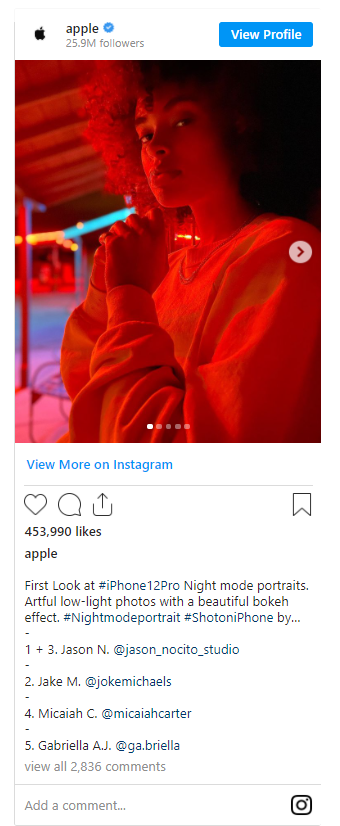
In this example, Apple found a way to activate its community and showcase its products in one brilliant marketing campaign called #ShorOnIphone.
Spotify: 2020 Wrapped
Spotify released a personalized summary of all the music subscribers listened to in a year. Every user’s Wrapped summary is accompanied by graphics that are shareable and social media-ready.

The Wrapped campaign also has quizzes, slides, videos, and personalized playlists. It is a genius campaign that improved engagement and brought many users back to the fold.
Its Time to Execute Your Ideas
Now that you have some great ideas about turbocharging your social media marketing, check out the features that will help you achieve your targets!
How to Overcome Social Media Marketing Challenges
While social media marketing provides many benefits, marketers will often face a variety of challenges including:
- Deciding what social media platforms to use
- Understanding the target audience and how to reach them on various social media platforms
- Determining how specific platforms will be used within existing or new marketing funnels.
- Whether social media platforms like Facebook and Instagram should be used for e-commerce purposes
- Integrating social media marketing strategies with other digital marketing strategies
- Designing unique content for particular platforms
If you want to learn in detail about these challenges & how to overcome them, I’ve another blog dedicated to it: 6 Social Media Marketing Challenges and How to Overcome Them. This blog discusses these challenges in more detail and several ways that digital marketers can easily overcome them.
Right now, to give you an overview, I’ve discussed three social media challenges & ways to overcome them.
Challenge #1 Staying Ahead of the Algorithm
For digital marketers & content producers, staying updated with the constantly changing social media algorithms is one of the biggest challenges in social media marketing. The algorithm changes affect almost all areas of social media strategy & content production.
The problem with the changes in the algorithm is that they do not roll out the same (or at the same time) on all platforms. In many cases, this difference in time and application of algorithm changes complicates social media marketing for small businesses that cannot invest more resources into platform monitoring and content revamp.
How to Overcome It
First of all, if you’re serious about social media marketing, you need to keep an eye on the changes, updates & development in social media algorithms. Try to adapt to the changes ASAP to reap the benefits.
You don’t have to be omnipresent. Be on social platforms where you find the relevant audience. Keep your focus on those platforms first, with a serious focus on what’s trending. If that content resonates with your brand voice and personality, try incorporating it into your publication lineup. You need to spend an hour at least every week to read about what’s new on the social media platforms of your choice. Whenever there’s a new feature or update, try to be the first to test it.
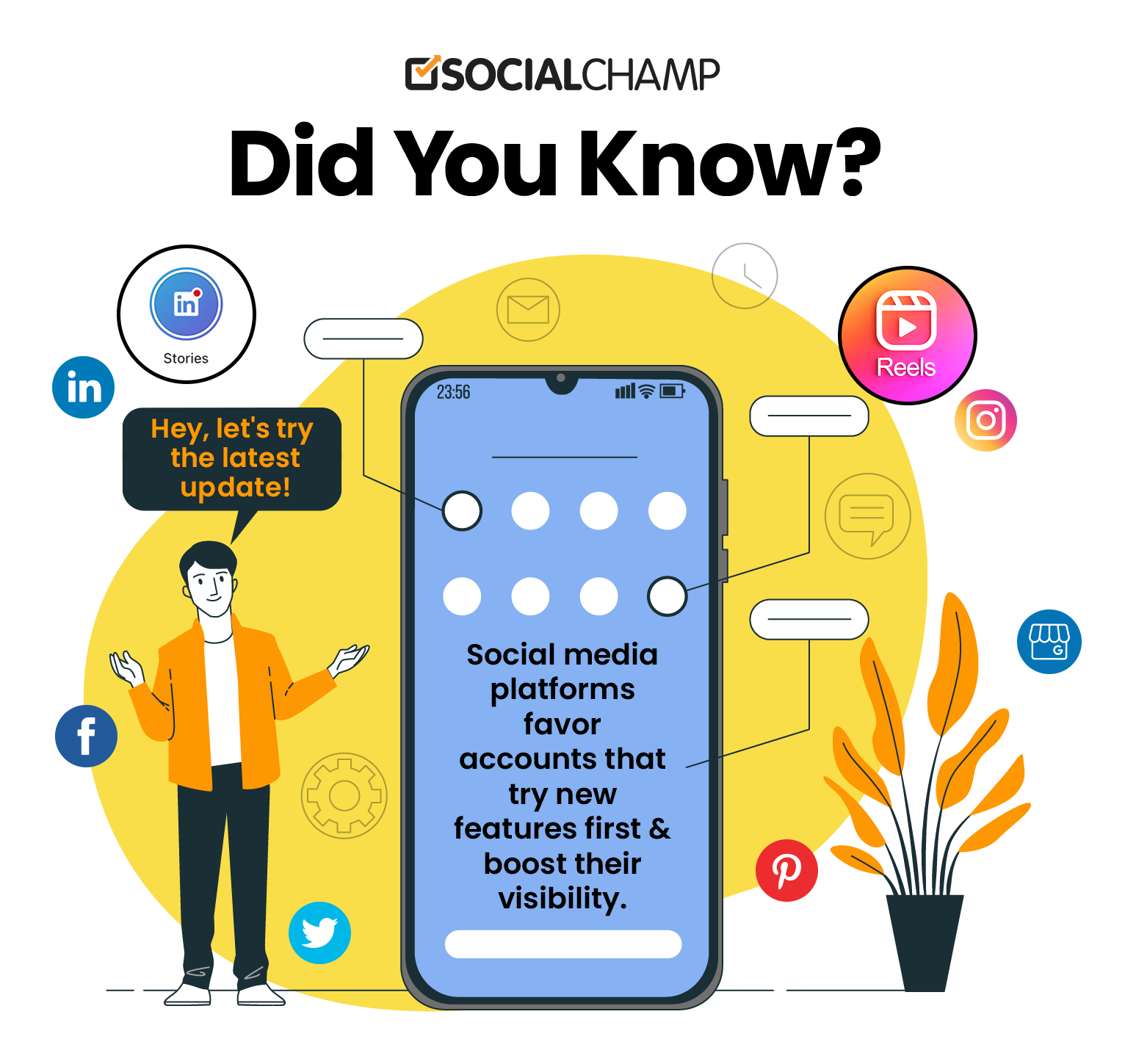 For example, recently, when Instagram introduced Reels, some early adopters that posted Reels reached around million followers in just a few months.
For example, recently, when Instagram introduced Reels, some early adopters that posted Reels reached around million followers in just a few months.
Challenge #2 Choosing Between Quantity or Quality
Choosing between quality & quantity has been an ongoing debate in social media marketing.
The most common mistake marketers make is getting all swept up in creating the content calendar. At the start of the month or quarter, when the team is all excited & energetic, they come up with several ideas.
In the excitement, it’s very easy to get distracted from what really matters. As a result, the team could set unrealistic deadlines & disregard the available resources. The rush to publish content on a regular schedule can compete with the need to create quality content that serves the brand and builds the reputation of the brand.
The most important question to ask here is this: What’s more important? Publishing fresh content regularly or crafting high-quality content pieces. I believe you’re smart enough to think about results. In the long run, your answer will be quality over quantity.
How to Overcome It
Finding the right balance is the key to success. When you give the quantity of content production priority over quality, you’ll end up sharing a lot of content but without any branding, structure, or intent.
Try to make a generic schedule for your social media posts. One way to overcome this challenge is to create your social media posts, don’t just create all your posts in bulk. Make sure that each post you’re creating has a purpose. Do in-depth research before producing content. Invest time in creating meaningful content that drives value. Also, invest time in designing your creative assets. Define your design templates, stick to the specific style & branding colors & fonts.
Challenge #3 Being Consistent with Posting
This one is a nightmare for social media managers. Even if you followed all the steps while building your social media strategy & content calendar, consistency still is a challenge for many managers.
Social media managers can relate to this situation: you’ve shared a post on social platforms & then disappeared for a week. Social media is often taken as a low-priority task. But, honestly, staying consistent with posting on social media can build your audience’s trust. Once you start posting at a specific time, your audience will look forward to it. But, with so much on your plate, how will this happen?
How to Overcome It
To stay consistent, you first need to create a social media calendar for the month ahead. Set your frequency. The key to staying consistent is scheduling your content ahead of time.
You can use a social media scheduling tool like Social Champ to schedule all your posts in your content calendar ahead of time. This will save the time & energy you spend in posting manually.
A social media scheduling tool helps a lot in managing your social media for you.
Are You Ready to Begin Your Social Media Marketing Journey?
I’ve tried to cover all the basics you need to know about social media marketing. From social media marketing terms to social media marketing challenges, it gives you a complete overview of everything. I hope this guide helps you & motivates you to be a better social media marketer.
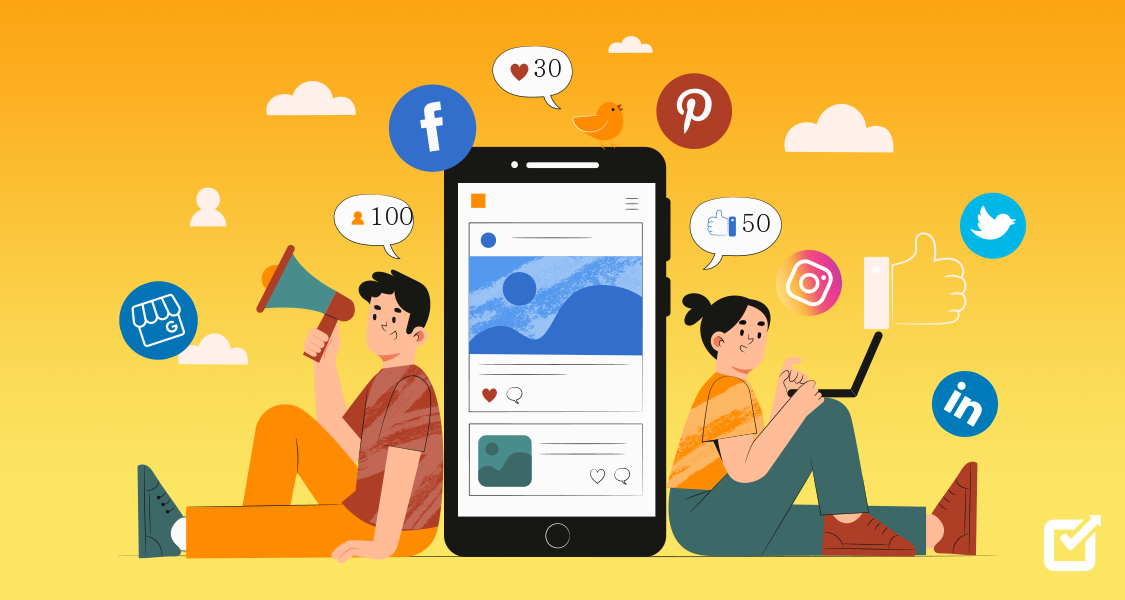












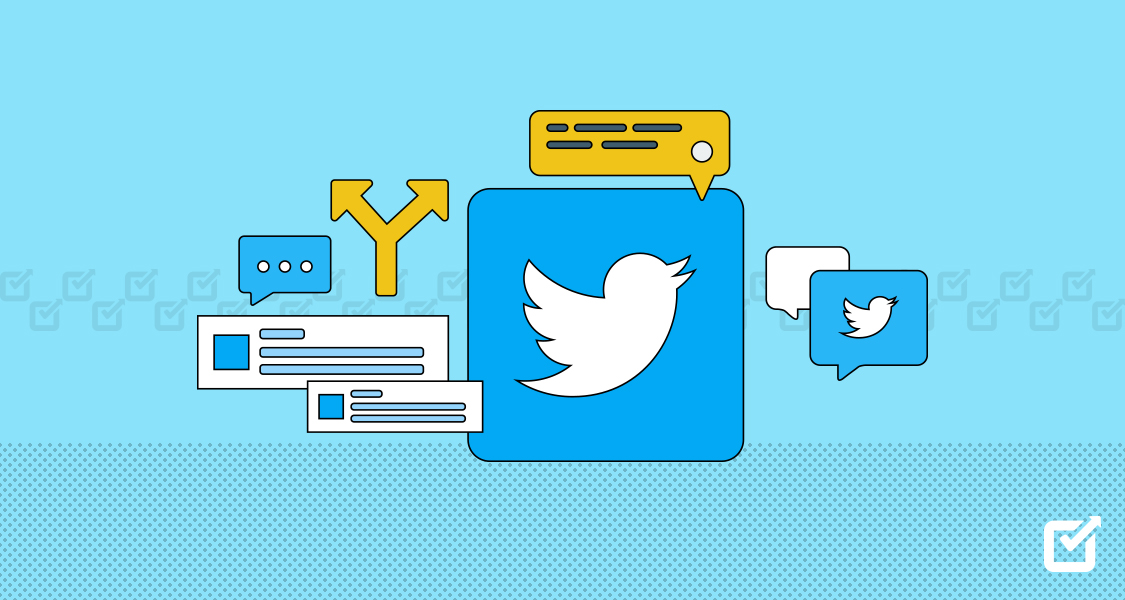

29 thoughts on “Social Media Marketing Guide: From Definitions to Challenges – All You Need to Know”
I just read your blog your information is very helpful regarding social media marketing trends.
Thanks for sharing such great information. It is really helpful to me. I always search to read the quality content and finally I found this in your post. keep it up!
Very Useful Information Regarding Social Media Marketing
Thank you for sharing! This is a really helpful post for digital marketers like me. Keep posting such great stuff!
This is a very useful article. thank you for this informative article about social media marketing.
You just listed everything that we need to know about social media marketing. Thanks a lot for sharing this. Creating a content strategy is indeed essential for your social media growth. Based on your experience, which type of content usually captures the most attention to your visitors?
Hi there,
It is a nice blog i really read it thoroughly, keep updating us with new one
Very informative post! This post gives truly quality information.
Hey!
I thoroughly enjoyed reading your post. You guys are doing a great job.
This list is awesome! I was thinking Instagram is THE BEST in social media marketing and I was searching Instagram followers app for that! but it seems if I sign up to another platforms and make my business bigger it will be more effective! thanks for your complete guide.
A Strategic Marketing Plan is a document that outlines an organization’s marketing goals and objectives for a specific period of time and how they will be achieved. It also includes an analysis of the organization’s current marketing situation, including its strengths and weaknesses.
You’ve done a wonderful job with this content. After reading this article I get to know all about social media marketing.
You’ve listed what we need to know about social media marketing. Thanks so much for sharing this. Creating a content strategy is really essential for improving your social media. Based on your experience, what kind of content usually attracts the most attention from your audience?
You’ve done a wonderful job with this content Thank you for giving such valuable input keep sharing in the future.
Thanks for posting an excellent article. Your site has provided the best information and is useful to all people.
I think Facebook is not much of a trend in marketing now. As the young audiences are not the major users of the platform, it can not be leveraged to its full potential. But yes it’s still the top for paid marketing. As opposed to Facebook, Instagram is very beneficial in organic marketing. There is an influx of small and new businesses coming on Instagram to build their brand identity better.
A very important blog for everyone. It also helps to creates a successful social media marketing strategy.
The blog and the post are absolutely fantastic! A lot of information is helpful in some or the other way. Keep updating the blog, looking forward to more content …Great job, keep it up.
Nice blog. Thank you for your valuable information.
Amazing article , full of knowledge. Thumbs Up
You’ve done a wonderful job with this content. After reading this article I get to know all about social media marketing. Thank you for giving such valuable input keep sharing in the future.
Here the information you included is very important to match the area of focus, besides we will be very happy if you regular set up like this post. Thanks in advance!!
Great article! As a beginner in social media marketing, I found these top 10 tips extremely helpful and practical. It’s crucial to have a solid foundation when entering this competitive landscape, and this blog post does an excellent job of providing actionable advice.
Hey
This blog give us lot of information is helpful in some or the other way. Keep updating the blog, looking forward to more content .
Nice blog.
Thanks for sharing
You are giving useful and important information. Thank You
I’m grateful for the valuable insights and perspectives you share on your blog.
Grateful for the valuable information you’ve shared here.
Its a very informative Post you shared here. Will you please share latest search engine update for beginner and experts
Thank you for sharing nice articles and valuable information
Shiva tour&travels
Thank you for this comprehensive guide! I found the section on creating a content strategy particularly useful.